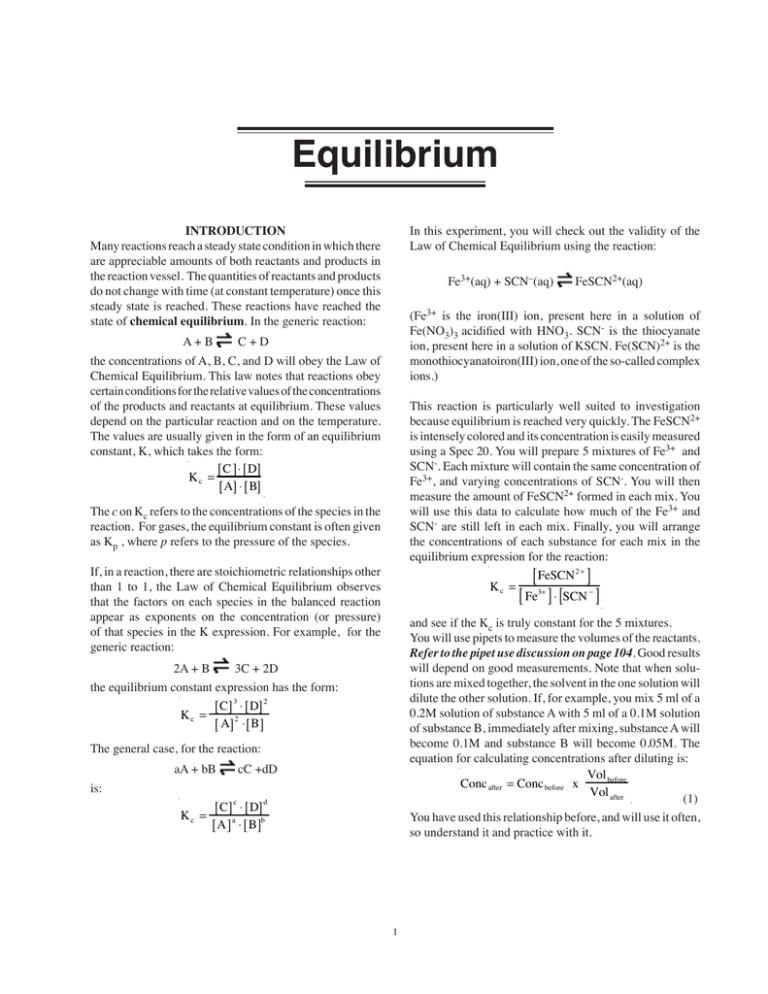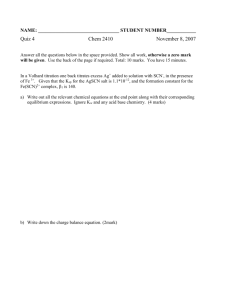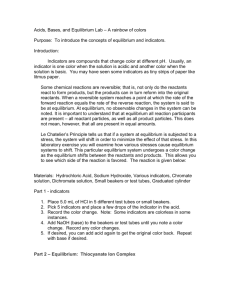Equilibrium
advertisement

Equilibrium Introduction Many reactions reach a steady state condition in which there are appreciable amounts of both reactants and products in the reaction vessel. The quantities of reactants and products do not change with time (at constant temperature) once this steady state is reached. These reactions have reached the state of chemical equilibrium. In the generic reaction: In this experiment, you will check out the validity of the Law of Chemical Equilibrium using the reaction: This reaction is particularly well suited to investigation because equilibrium is reached very quickly. The FeSCN2+ is intensely colored and its concentration is easily measured using a Spec 20. You will prepare 5 mixtures of Fe3+ and SCN-. Each mixture will contain the same concentration of Fe3+, and varying concentrations of SCN-. You will then measure the amount of FeSCN2+ formed in each mix. You will use this data to calculate how much of the Fe3+ and SCN- are still left in each mix. Finally, you will arrange the concentrations of each substance for each mix in the equilibrium expression for the reaction: FeSCN 2 + Kc = Fe3+ ⋅ SCN − and see if the Kc is truly constant for the 5 mixtures. You will use pipets to measure the volumes of the reactants. Refer to the pipet use discussion on page 104. Good results will depend on good measurements. Note that when solutions are mixed together, the solvent in the one solution will dilute the other solution. If, for example, you mix 5 ml of a 0.2M solution of substance A with 5 ml of a 0.1M solution of substance B, immediately after mixing, substance A will become 0.1M and substance B will become 0.05M. The equation for calculating concentrations after diluting is: Vol before Conc after = Conc before x Vol after (1) The c on Kc refers to the concentrations of the species in the reaction. For gases, the equilibrium constant is often given as Kp , where p refers to the pressure of the species. If, in a reaction, there are stoichiometric relationships other than 1 to 1, the Law of Chemical Equilibrium observes that the factors on each species in the balanced reaction appear as exponents on the concentration (or pressure) of that species in the K expression. For example, for the generic reaction: [ 2A + B 3C + 2D the equilibrium constant expression has the form: [ C] 3 ⋅ [ D] 2 Kc = [ A] 2 ⋅ [ B] The general case, for the reaction: aA + bB Kc = FeSCN2+(aq) (Fe3+ is the iron(III) ion, present here in a solution of Fe(NO3)3 acidified with HNO3. SCN- is the thiocyanate ion, present here in a solution of KSCN. Fe(SCN)2+ is the mono­thio­cyan­atoiron(III)­ion, one of the so-called complex ions.) A+B C+D the concentrations of A, B, C, and D will obey the Law of Chemical Equilibrium. This law notes that reactions obey certain conditions for the relative values of the concentrations of the products and reactants at equilibrium. These values depend on the particular reaction and on the temperature. The values are usually given in the form of an equilibrium constant, K, which takes the form: [ C ] ⋅ [ D] Kc = [ A] ⋅ [ B] is: Fe3+(aq) + SCN–(aq) cC +dD [ C] c ⋅ [ D] d [ A ] a ⋅ [ B]b [ ][ ] ] You have used this relationship before, and will use it often, so understand it and practice with it. 1 Work in Pairs Supplies: • 2 cuvets • One 5 ml fixed volume pipet (Volumetric Pipet), two 5 ml variable volume pipets (Mohr-type Measuring Pipet) • 1 pipetting aid • A calibration curve • 5-18x150 test tubes (large) from drawer • Use clean, dry 50 ml beakers to bring about 30 ml of 2.00 x 10-3M Fe(NO3)3 solution and about 20 ml of 2.00 x 10-3M KSCN solution to your work area. Put about 20 ml of deionized water into another 50 ml beaker. • 400 ml beaker for waste Mixing instructions: The pipets should be clean and dry. If not, refer to the pipet use discussion for the proper method of rinsing. Label the 5 test tubes 1 to 5 and set them in a test tube rack. Use the volumetric pipet to add 5.00 ml of the Fe3+ solution into each of the 5 test tubes. Use one of the Mohr-type measuring pipets to add 1.00 ml of the SCN- solution into test tube 1, 2.00 ml into test tube 2, etc., until 5.00 ml goes into test tube 5. Now use the other Mohr-type pipet to add 4.00 ml deionized water into test tube 1, 3.00 ml into test tube 2, 2.00 into test tube 3, and 1.00 ml into test tube 4. Each test tube now has 10.00 ml total volume. The table below summarizes the mixing quantities. You will use a Spec 20 to determine the concentration of the FeSCN2+ formed. Use a stirring rod to mix each solution. Mix with vigorous up and down elliptical agitation, being careful not to poke out the bottom of the test tube. Rinse and dry the stirrer between test tubes. Spec 20 setup: Analog Spec 20: Refer to page 5 for Spec 20 information. Turn the Spec 20 on with the left front knob as you enter the lab to allow for warm-up. Make sure the sample holder is empty and its cap is closed. After you prepare the solutions described below, with the machine warmed up, use the left front knob to set the pointer to the left zero on the dial. Set the wavelength on the Spec 20 at 45 nm, the wavelength of maximum absorption for this complex ion. The upper right dial is the wavelength set dial. Insert a cuvet with about 3 cm height of deionized water into the sample holder. Use the right front knob to set the needle to the right zero on the dial, the zero on the absorption scale. This zeroes out the solvent. The machine is now ready to measure the absorption of each of the 5 mixtures you will use. Digital Spec 20: Refer to page 5 for Spec 20 information. Turn the Spec 20 on with the left front knob as you enter the lab to allow for warm-up. Make sure the sample holder is empty and its cap is closed, and the lever on the front left of the machine is turned to the left. After you prepare the solutions described below, with the machine warmed up, set the wavelength on the Spec 20 at 45 nm, the wavelength of maximum absorption for this complex ion. The upper right dial is the wavelength set dial. Turn the left front knob until 0 is displayed. Set the Mode to A. Insert a cuvet with about 3 cm height of deionized water into the sample holder. Turn the right front knob until 0A shows on the display. This may take several full turns. The machine is now ready to measure the absorption of each of the 5 mixtures you will use. One cuvet contains deionized water, which you used to zero the spectrophotometer. Pour about 3 cm height of sample 1 into the other cuvet, place it into the zeroed Spec 20, record the absorption on the data sheet. Dispose of the liquid from the cuvet into the 400 ml beaker. Add about one ml from sample 2 to rinse the cuvet. Dump the rinse liquid into the 400 ml beaker. Add another ml from sample 2 to further rinse the cuvet. Dump into the 400 ml beaker. Finally add about 3 cm height of liquid from sample 2 into the cuvet and place it into the Spec 20. Record the absorption. Repeat this procedure for each of the remaining 3 samples. There should be a smooth trend of values for the absorptions in samples 1 to 5, close to about 0.1 apart. If the trend is much less than 0.1 apart, check with the instructor. If any one value does not follow the trend, repeat the measurement for that sample, or even re-mix and then repeat the measurement. You are now ready to do the calculations. To dispose of the solutions: Combine them all into the 400 ml beaker, add about 3 g of sodium hydrogen carbonate (6 cm on the scoopula) from the plastic bottle on the lab table. When the bubbling ceases, dump the liquid into the sink. S U MM A R Y O F SAM PLE P R EP A R A T ION Test Tube Nu mber 1 Volume Fe 3+ solution 2 3 4 5 5.00 5.00 5.00 5.00 5.00 Volume SCN – solution 1.00 2.00 3.00 4.00 5.00 Volume H 2O (deionized) 4.00 3.00 2.00 1.00 0 2 D AT A T A B L E Test Tube Num ber 1 Absorbance of F eS C N 2 3 4 5 2+ C A L C U L AT I O N S 1. C alculate the concentrations of the starting m aterials after m ixing. Use equation 1 on page 43. The stock concentrations of the F e3+ and the S C N – are 2.00 x 10 -3 M . The concentration after m ixing and before reacting is called the initial concentration. 1 2 3 4 5 [F e3+]i ni t i a l M M M M M [S C N ]i ni t i a l M M M M M – 2. Use the calibration curve to find the [F eS C N 2+]e q for each sam ple. Write the values in the table below. F ind the equilibrium concentrations of the F e3+ and S C N - using the relationships: [F e3+]i ni t i a l – [F eS C N 2+]e q [F e3+]e q = [S C N – ]i ni t i a l – [F eS C N 2+]e q = and [S C N – ]e q Write these values below. (S ubtracting concentrations rather than m oles works if the volum e is the sam e for all substances. Note that it takes one m ole of F e3+ and one m ole of S C N – to form one m ole of F eS C N 2+.) 3. [F eS C N 2+]e q M M M M M 3+ [F e ]e q M M M M M [S C N – ]e q M M M M M C alculate the K c for each sam ple. Use the relationship: Note that K c requires equilibr ium concentrations. Kc = [FeSCN [ Fe 3+ 2+ ] ] ⋅[ SCN − ] (Use the correct units on the values for the K c ) Kc K c average 4. F ind the % deviation for each K value from the average: % deviation = % deviation 3 Kc − Kc Kc average average x 100 Name_________________________________________ Grade___________ Date ___________ questions 1. What if the equation for the equilibrium were: Fe3+(aq) + 2SCN-(aq) for the Kc be written? Fe(SCN)2+(aq). How would the expression 2. If the reaction in question 1 is correct, the concentrations of Fe3+ at equilibrium in each sample would be the same as you calculated in part 2 of the calculations section. But the values for the equilibrium concentrations of SCN- would change. They would be calculated as follows: [SCN-]initial - 2[[Fe(SCN)2+] = [SCN-]eq. Why is that? (Assume that the Spec 20 measurements still gave correct values for the concentration of the product.) 3. Look at the % deviation section of the calculations table. Choose the two samples with the least % deviation. Write the values from the table for the [SCN-]eq for these two: __________M, __________M. Use the equation in question 2 to show what these values would be if the reaction equation in question 1 is the actual equation for this equilibrium. (Show your work.) 4. Use the values calculated for the [SCN-]eq in question 3 and the Kc expression from question 1 to calculate the values of Kc for the two samples under the conditions raised by these questions. Show the units along with the numerical value for the two Kc's. Divide the larger number by the smaller number, and multiply by 100 to see the percentage differences between them. Are they farther apart than the two K's you used for the concentration data? If so, this shows that the law of equilibrium does not apply if the stoichiometry used is not the actual stoichiometry of the reaction. 5. When you added the sodium hydrogen carbonate to the waste solutions, you were neutralizing the nitric acid present in the Fe(NO3)3 solution. What is the formula for nitric acid? Show a balanced chemical equation for the reaction that took place between nitric acid and sodium hydrogen carbonate. Remember, there was fizzing. One of the products was a gas. 4 Sample Measurement The sequence for sample measurement is: a. Select wavelength using Wavelength Control. b. With sample compartment empty and cover closed, adjust Zero Control so that the meter reads zero (on the left side of the dial). c. Insert reference blank into the sample compartment and set Absorbance Control to zero (on the right side of the dial). d. Insert unknown sample into the sample compartment and read measurement from meter in percent transmittance or absorbance. 5


